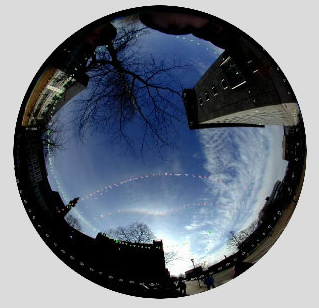Supralateral arc II
Supralateral Arc II: A Mesmerizing Atmospheric Phenomenon
The supralateral arc is a captivating atmospheric optical phenomenon that stretches from near the zenith down to the horizon. It is a rare sight, often confused with other similar optical effects, such as the 46° halo. In this article, we will delve deeper into the intricacies of the supralateral arc II, exploring its formation, characteristics, and how it can be distinguished from other atmospheric phenomena.
Formation of the Supralateral Arc II
The supralateral arc II is formed by the interaction of sunlight with ice crystals in the atmosphere. These ice crystals are typically plate-shaped and horizontally oriented. When sunlight enters these crystals, it undergoes refraction and internal reflection, leading to the bending and dispersion of light. The supralateral arc II is specifically produced by the refraction and reflection of sunlight within column-shaped ice crystals.
Characteristics of the Supralateral Arc II
The supralateral arc II appears as a curving band of light, extending from near the zenith down to the horizon. It is often parallel to the upper tangent arc and can be seen alongside other optical phenomena, such as the 46° halo and the parhelic circle. The supralateral arc II is known for its vibrant colors, ranging from red on the inside to blue on the outside. Its intensity can vary depending on atmospheric conditions, such as the size and orientation of the ice crystals.
Distinguishing the Supralateral Arc II from Similar Phenomena
Differentiating the supralateral arc II from other atmospheric optical phenomena can be challenging due to their similar appearances. However, careful observation and understanding of their distinct characteristics can help in accurate identification. Here are some key points to consider when distinguishing the supralateral arc II from other phenomena:
- The supralateral arc II appears as a continuous band of light, extending from near the zenith down to the horizon, whereas the 46° halo forms a complete circle around the Sun or Moon.
- The supralateral arc II exhibits vibrant colors, ranging from red on the inside to blue on the outside, while the 46° halo appears as a whitish or colorless circle.
- The supralateral arc II is parallel to the upper tangent arc, whereas the 46° halo is not.
Observations and Simulations
To better understand the complexities of the supralateral arc II, researchers have conducted observations and simulations. One notable observation was captured by Ant Veal et.al. at the University of Birmingham. The all-sky view image showcases the supralateral arc II stretching from near the zenith down to the campus clock tower.
Simulations have also been conducted to simulate the formation of the supralateral arc II and its interaction with other atmospheric optical phenomena. By superimposing simulations onto images, researchers have highlighted the challenges in distinguishing between the supralateral arc II and the 46° halo. Red spots trace the supralateral and upper tangent arcs, while blue spots represent the 46° and 22° circular halos formed by poorly oriented crystals. Green spots mark the parhelic circle formed by plate-shaped crystals.
Conclusion
The supralateral arc II is a mesmerizing atmospheric optical phenomenon that adds an enchanting touch to the sky. Its formation through the refraction and reflection of sunlight within column-shaped ice crystals creates a beautiful band of light stretching from near the zenith to the horizon. Distinguishing it from similar phenomena, such as the 46° halo, requires careful observation and an understanding of their distinct characteristics. By conducting observations and simulations, researchers continue to unravel the mysteries of the supralateral arc II, enhancing our appreciation for the wonders of the natural world.

The England 9th February '01 display from the University of Birmingham.
The display had faded somewhat when Ant Veal et.al. captured this all-sky view at 12.35 UTC.
The supralateral arc stretches from near to the zenith right down to the campus clock tower at left.
Simulations of the supralateral arc and a 46� halo overlie the image below. They show how difficult it can be to distinguish between them.
Image �Ant Veal et. al., reproduced with permission.

Superimposed simulation
Red spots trace supralateral and upper tangent arcs from horizontal column crystals.
Blue spots trace 46� and 22� circular halos formed by poorly oriented crystals.
Green spots mark the parhelic circle - plate crystals.
Grey dashes are the simulation horizon (the camera was tilted slightly from the zenith).
Note: this article has been automatically converted from the old site and may not appear as intended. You can find the original article here.
Reference Atmospheric Optics
If you use any of the definitions, information, or data presented on Atmospheric Optics, please copy the link or reference below to properly credit us as the reference source. Thank you!
-
<a href="https://atoptics.co.uk/blog/supralateral-arc-ii/">Supralateral arc II</a>
-
"Supralateral arc II". Atmospheric Optics. Accessed on November 26, 2024. https://atoptics.co.uk/blog/supralateral-arc-ii/.
-
"Supralateral arc II". Atmospheric Optics, https://atoptics.co.uk/blog/supralateral-arc-ii/. Accessed 26 November, 2024
-
Supralateral arc II. Atmospheric Optics. Retrieved from https://atoptics.co.uk/blog/supralateral-arc-ii/.